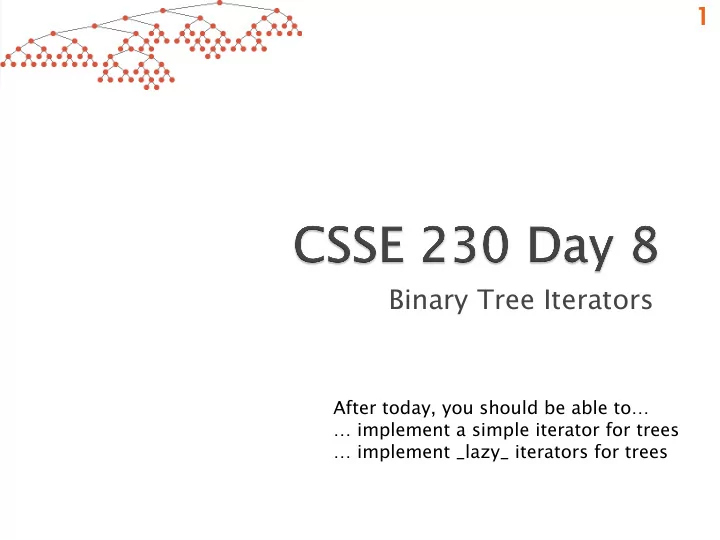

1 Binary Tree Iterators After today, you should be able to… … implement a simple iterator for trees … implement _lazy_ iterators for trees
} Exam Thu night: check room! } No class Friday } Still due on Friday: ◦ Stacks & Queues Partner Evaluation (on Moodle) ◦ Homework 3 } Doublets progress? ◦ Overview of workflow ◦ Questions?
Quiz question: What became clear to you as a result of class? Another 230 student, not to be outdone: Trees are unbeLEAFable fun when you can use recursion to traverse them, which helps you get to the ROOT of the problem.
What if we want to iterate over the elements in the nodes of the tree one-at-a-time instead of just printing all of them?
2 } In Java, specified by java.util.Iterator<E>
For any data structure that implements Iterable, (i.e., it defines the factory method iterator() which returns an iterator over the data) we can use the “foreach” syntax: for (Integer val : iterableDataStruct) { ... } This is equivalent to: for (Iterator<Integer> itr = iterableDataStruct.iterator(); itr.hasNext(); ) { Integer val = itr.next(); ... }
Creating a tree iterator would allow us to traverse a tree iteratively (rather than recursively). for (T item : binarySearchTree) { ... } We could have different iterators for different traversal orders. Iterator<T> preOrderIt = new PreOrderIterator(); while (preOrderIt.hasNext()) { T item = preOrderIt.next(); ... }
} Pros: easy to write. } Cons? We’ll see shortly! Tree level (header) ArrayList<T> list Node level (recursion) = new ArrayList<T>(); root.toArrayList(list); list list list “ P u t c o n t e n t s o f y o u r t r e e i n t h i s l i s 2 t ” NULL_NODE x list .add(x) return list; return left.toArrayList(list); right.toArrayList(list); 1 3 “Put contents of your “Put contents of your tree in this list” tree in this list” toArrayList()
3 } Consider a tree with 1 million elements. } What if we only end up iterating over the first 10 elements? } To improve efficiency, the iterator should iterate on the tree itself. ◦ Constructor should do minimal setup ◦ On each .next() query, only do as much work as needed to respond & set up for future queries ◦ In this context, laziness means efficiency!
4-5 } Preorder: root, left, right x 1 visit 2 3 “preorder-traverse “preorder-traverse subtree” subtree” } Rather than carrying out all instructions at once, we should lazily handle them } Store “tokens” representing pending instructions in a data structure (what data structure?)
6 } Inorder: left, root, right x 2 visit 1 “inorder-traverse 3 “inorder-traverse subtree” subtree” } Consider two types of instruction tokens: ◦ 0: “traverse subtree” ◦ 1: “visit node and traverse its right subtree” Could represent tokens with, class Token { say, a compound class: BinaryNode node; int tag; Use a Stack<Token> to store } instructions
7 } What happens if we replace the Stack in the preorder iterator with a Queue?
Suggestion: work on Doublets with your partner!
Recommend
More recommend